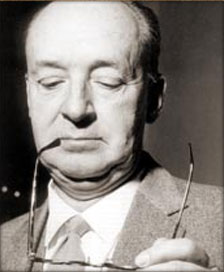Line 17: And then the gradual; Line 29: gray
By an extraordinary coincidence (inherent perhaps in the contrapuntal nature of Shade’s art) our poet seems to name here (gradual, gray) a man, whom he was to see for one fatal moment three weeks later, but of whose existence at the time (July 2) he could not have known. Jakob Gradus called himself variously Jack Degree or Jacques de Grey, or James de Gray, and also appears in police records as Ravus, Ravenstone, and d’Argus. Having a morbid affection for the ruddy Russia of the Soviet era, he contended that the real origin of his name should be sought in the Russian word for grape, vinograd, to which a Latin suffix had adhered, making it Vinogradus. His father, Martin Gradus, had been a Protestant minister in Riga, but except for him and a maternal uncle (Roman Tselovalnikov, police officer and part-time member of the Social-Revolutionary party), the whole clan seems to have been in the liquor business. Martin Gradus died in 1920, and his widow moved to Strasbourg where she soon died, too. Another Gradus, an Alsatian merchant, who oddly enough was totally unrelated to our killer but had been a close business friend of his kinsmen for years, adopted the boy and raised him with his own children. It would seem that at one time young Gradus studied pharmacology in Zurich, and at another, traveled to misty vineyards as an itinerant wine taster. We find him next engaging in petty subversive activities – printing peevish pamphlets, acting as messenger for obscure syndicalist groups, organizing strikes at glass factories, and that sort of thing. Sometime in the forties he came to Zembla as a brandy salesman. There he married a publican’s daughter. His connection with the Extremist party dates from its first ugly writhings, and when the revolution broke out, his modest organizational gifts found some appreciation in various offices. His departure for Western Europe, with a sordid purpose in his heart and a loaded gun in his pocket, took place on the very day that an innocent poet in an innocent land was beginning Canto Two of Pale Fire. We shall accompany Gradus in constant thought, as he makes his way from distant dim Zembla to green Appalachia, through the entire length of the poem, following the road of its rhythm, riding past in a rhyme, skidding around the corner of a run-on, breathing with the caesura, swinging down to the foot of the page from line to line as from branch to branch, hiding between two words (see note to line 596), reappearing on the horizon of a new canto, steadily marching nearer in iambic motion, crossing streets, moving up with his valise on the escalator of the pentameter, stepping off, boarding a new train of thought, entering the hall of a hotel, putting out the bedlight, while Shade blots out a word, and falling asleep as the poet lays down his pen for the night.
Line 27: Sherlock Holmes
A hawk-nosed, lanky, rather likable private detective, the main character in various stories by Conan Doyle. I have no means to ascertain at the present time which of these is referred to here but suspect that our poet simply made up this Case of the Reversed Footprints.
Lines 34-35: Stilettos of a frozen stillicide
How persistently our poet evokes images of winter in the beginning of a poem which he started composing on a balmy summer night! The mechanism of the associations is easy to make out (glass leading to crystal and crystal to ice) but the prompter behind it retains his incognito. One is too modest to suppose that the fact that the poet and his future commentator first met on a winter day somehow impinges here on the actual season. In the lovely line heading this comment the reader should note the last word. My dictionary defines it as “a succession of drops falling from the eaves, eavesdrop, cavesdrop.” I remember having encountered it for the first time in a poem by Thomas Hardy. The bright frost has eternalized the bright eavesdrop. We should, also note the cloak-and-dagger hint-glint in the “svelte stilettos” and the shadow of regicide in the rhyme.
Lines 39-40: Was close my eyes, etc.
These lines are represented in the drafts by a variant reading: 39 ……….. and home would haste my thieves
40 The sun with stolen ice, the moon with leaves
One cannot help recalling a passage in Timon of Athens (Act IV, Scene 3) where the misanthrope talks to the three marauders. Having no library in the desolate log cabin where I live like Timon in his cave, I am compelled for the purpose of quick citation to retranslate this passage into English prose from a Zemblan poetical version of Timon which, I hope, sufficiently approximates the text, or is at least faithful to its spirit:
The sun is a thief: she lures the sea and robs it.
The moon is a thief: he steals his silvery light from the sun.
The sea is a thief: it dissolves the moon.
For a prudent appraisal of Conmal's translations of Shakespeare's works, see note to line 962.Line 42: I could make out
By the end of May I could make out the outlines of some of my images in the shape his genius might give them; by mid-June I felt sure at last that he would recreate in a poem the dazzling Zembla burning in my brain. I mesmerized him with it, I saturated him with my vision, I pressed upon him, with a drunkard’s wild generosity, all that I was helpless myself to put into verse. Surely, it would not be easy to discover in the history of poetry a similar case – that of two men, different in origin, upbringing, thought associations, spiritual intonation and mental mode, one a cosmopolitan scholar, the other a fireside poet, entering into a secret compact of this kind.
